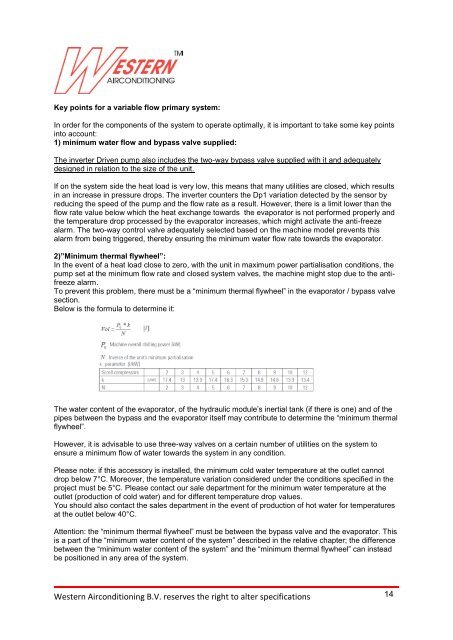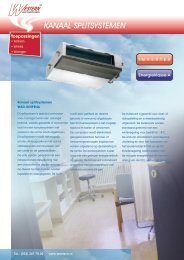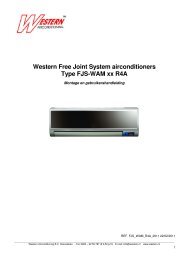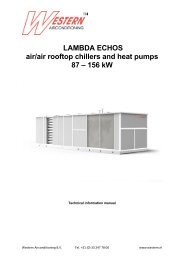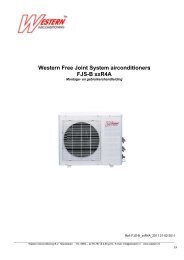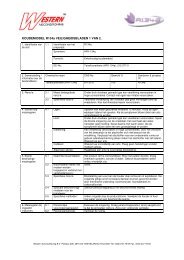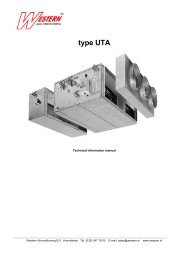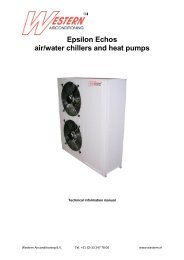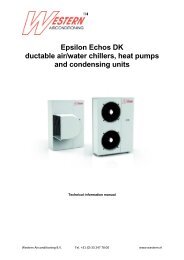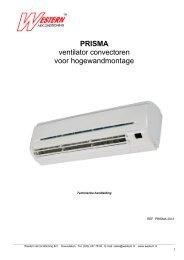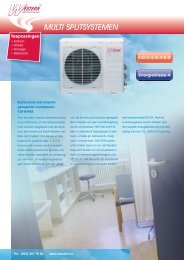Zeta Echos air/water chillers and heat pumps - Western ...
Zeta Echos air/water chillers and heat pumps - Western ...
Zeta Echos air/water chillers and heat pumps - Western ...
You also want an ePaper? Increase the reach of your titles
YUMPU automatically turns print PDFs into web optimized ePapers that Google loves.
Key points for a variable flow primary system:<br />
In order for the components of the system to operate optimally, it is important to take some key points<br />
into account:<br />
1) minimum <strong>water</strong> flow <strong>and</strong> bypass valve supplied:<br />
The inverter Driven pump also includes the two-way bypass valve supplied with it <strong>and</strong> adequately<br />
designed in relation to the size of the unit.<br />
If on the system side the <strong>heat</strong> load is very low, this means that many utilities are closed, which results<br />
in an increase in pressure drops. The inverter counters the Dp1 variation detected by the sensor by<br />
reducing the speed of the pump <strong>and</strong> the flow rate as a result. However, there is a limit lower than the<br />
flow rate value below which the <strong>heat</strong> exchange towards the evaporator is not performed properly <strong>and</strong><br />
the temperature drop processed by the evaporator increases, which might activate the anti-freeze<br />
alarm. The two-way control valve adequately selected based on the machine model prevents this<br />
alarm from being triggered, thereby ensuring the minimum <strong>water</strong> flow rate towards the evaporator.<br />
2)”Minimum thermal flywheel”:<br />
In the event of a <strong>heat</strong> load close to zero, with the unit in maximum power partialisation conditions, the<br />
pump set at the minimum flow rate <strong>and</strong> closed system valves, the machine might stop due to the antifreeze<br />
alarm.<br />
To prevent this problem, there must be a “minimum thermal flywheel” in the evaporator / bypass valve<br />
section.<br />
Below is the formula to determine it:<br />
The <strong>water</strong> content of the evaporator, of the hydraulic module’s inertial tank (if there is one) <strong>and</strong> of the<br />
pipes between the bypass <strong>and</strong> the evaporator itself may contribute to determine the “minimum thermal<br />
flywheel”.<br />
However, it is advisable to use three-way valves on a certain number of utilities on the system to<br />
ensure a minimum flow of <strong>water</strong> towards the system in any condition.<br />
Please note: if this accessory is installed, the minimum cold <strong>water</strong> temperature at the outlet cannot<br />
drop below 7°C. Moreover, the temperature variation considered under the conditions specified in the<br />
project must be 5°C. Please contact our sale department for the minimum <strong>water</strong> temperature at the<br />
outlet (production of cold <strong>water</strong>) <strong>and</strong> for different temperature drop values.<br />
You should also contact the sales department in the event of production of hot <strong>water</strong> for temperatures<br />
at the outlet below 40°C.<br />
Attention: the “minimum thermal flywheel” must be between the bypass valve <strong>and</strong> the evaporator. This<br />
is a part of the “minimum <strong>water</strong> content of the system” described in the relative chapter; the difference<br />
between the “minimum <strong>water</strong> content of the system” <strong>and</strong> the “minimum thermal flywheel” can instead<br />
be positioned in any area of the system.<br />
<strong>Western</strong> Airconditioning B.V. reserves the right to alter specifications 14


